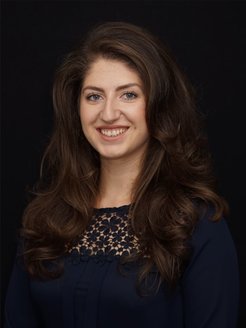Dr. Jasmina Gačanin

Jasmina Gačanin, Preisträgerin des Karl-von-Frisch- (VBiO) und Scheffel-Preises (Literarische Gesellschaft), erhielt ihre B.Sc. (2013) und M.Sc. (2015) Abschlüsse in Biochemie, Universität Ulm, Deutschland, als Stipendiatin der Studienstiftung des deutschen Volkes. Nachfolgend entwickelte sie im Rahmen ihrer Dissertation in der Gruppe von Prof. Dr. Tanja Weil an der Universität Ulm multifunktionale Hydrogele für die Medizin und graduierte mit Auszeichnung (summa cum laude) in 2020. Jasmina setzte dann ihre Arbeiten als Postdoktorandin in der Weil Gruppe am MPI-P in Mainz als Projektverantwortliche am MPI-P im Rahmen zweier Industriekooperationen fort: die BMBF Projekte "Injizierbare, adaptive Hydrogele nächster Generation" (InGel-NxG) und "Neue bio-basierte Rheologiemodifikatoren” (Kosmogel). 2023 wurde Jasmina zur Peretti-Schmucker Stipendiatin ernannt, wobei die Position von der “The Nando and Elsa Peretti Foundation“ gestiftet wurde. Das Forschungsprojekt wird sich mit einem dringenden Bedarf in der Behandlung von Haut durch neu entwickelte innovative Biomaterialien befassen - Hydrogel-Zell-Formulierungen als lebende Biomaterialien für die Behandlung von Hautkrankheiten der nächsten Generation, Wundheilung oder Gewebezüchtung. Jasmina wurde zudem 2023 zur Gruppenleiterin am MPI-P befördert und leitet seither die neue Forschungsgruppe „Zell-instruktive Materialien“ mit Schwerpunkt auf der Entwicklung multifunktionaler 3D-Biohybrid-Materialien für medizinische Anwendungen, mit besonderer Ausrichtung auf regenerative Medizin und Körperpflege.
Forschungsinteressen
Zell-instruktive Materialien: Biohybride für Anwendungen in der Medizin, Gesundheitsversorgung und Körperpflege
Unsere Forschung konzentriert sich auf multifunktionale Hybrid-Hydrogele für medizinische Anwendungen wie Tissue-Engineering und Drug-Delivery unter Verwendung verschiedener Biomoleküle wie Proteine, Peptide und DNA. Hydrogele, die zelluläre Funktionen instruieren, um z.B. geschädigtes Gewebe zu regenerieren, und dabei eine minimalinvasive Anwendung und therapeutische Optionen ermöglichen, sind in der Medizin sehr gefragt. Derzeitige Systeme können selten alle nötigen Materialeigenschaften abdecken (Definition, Biokompatibilität, Selbstheilung…). Angesichts dessen und inspiriert durch das komplexe Zusammenspiel von Molekülen in der Natur erforschen wir die Kombination der Stabilität kovalenter Bindungen mit dem mittels supramolekularen Chemie eingebrachten dynamischen Verhalten, um Zell-instruktive Materialien zu entwickeln, die Interaktivität, Responsivität und Anpassbarkeit eröffnen. Proteinabgeleitete Grundgerüste sind hier sehr attraktiv, wenn sie mit supramolekularen Gelatoren aus DNA oder Nanofaser-bildenden Peptiden kombiniert werden: die Gele zeigen beeindruckende Material- und biologische Eigenschaften wie thixotropes Verhalten und Biokompatibilität.[1-4] Während DNA-Programmierbarkeit die kontrollierte Freisetzung bioaktiver Proteine, z.B. zur Steuerung von Zellpopulationen, ermöglicht[1,2], erlauben vernetzende Peptide die Gel-Injektion[3]. In Kooperationen mit Partnern aus der Industrie wurden Gelplattformen als neuartige Behandlungsoptionen oder als biobasierte Rheologiemodifikatoren erforscht. Insgesamt wird in Grundlagenforschung und anwendungsnahen Projekten ein breiter, interdisziplinärer Ansatz verfolgt (Synthese, Material-charakterisierung (Rheologie, Zellstudien), Biofabrikation).
Wichtigste Errungenschaften: Depsi-Peptid-Prinzip zur Kontrolle der Strukturbildung in Peptidnanofibrillen und die Implementierung der strukturellen Kontrolle als Plattform über mehrere Längenskalen: Peptide – Biohybride – Hydrogele. Durch die Synthese von selbstassemblierenden Peptiden als sogenannte Depsi-Peptide wird die intrinsische Strukturbildung in Lösungen kontrollierbar. Dies eröffnet eine definierte Chemie indem die Aggregation der Peptide gezielt aktivierbar wird.
